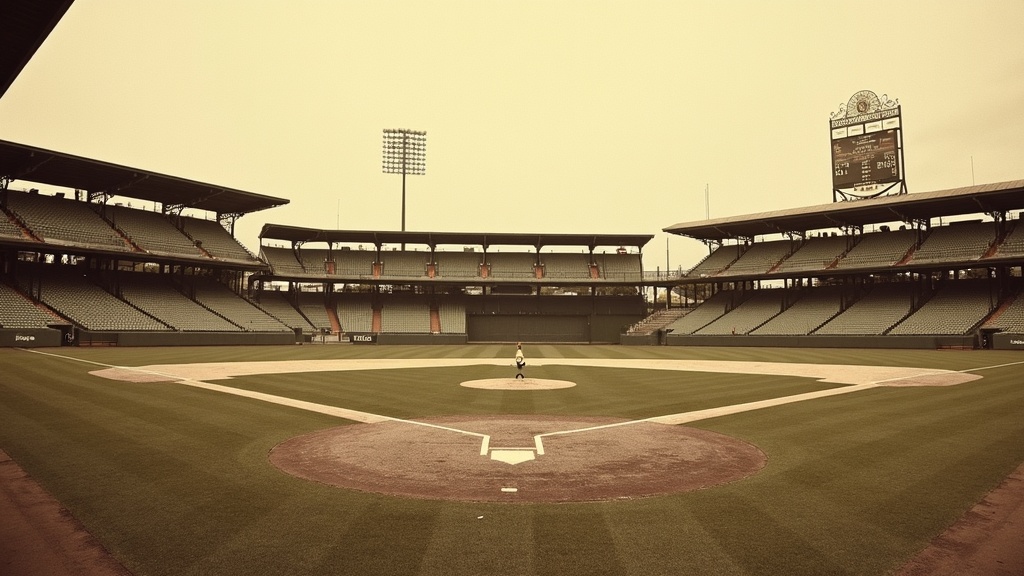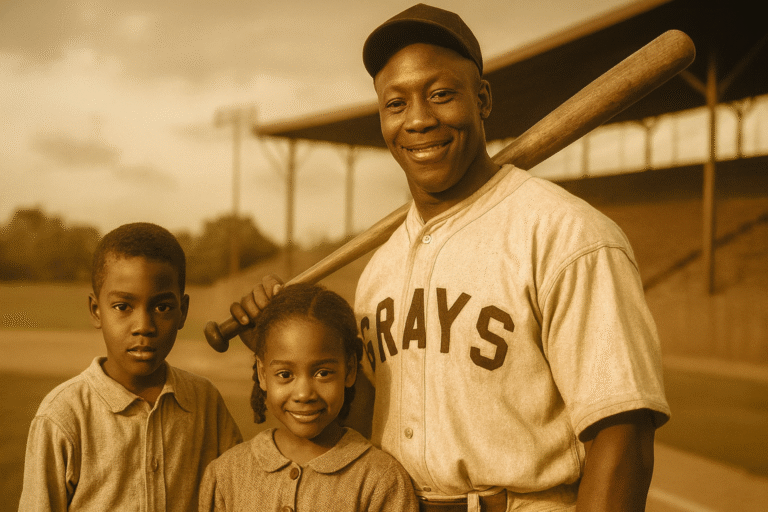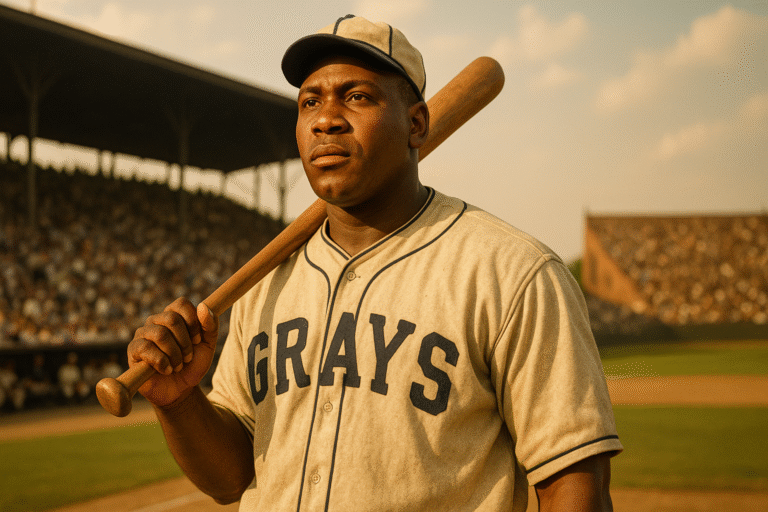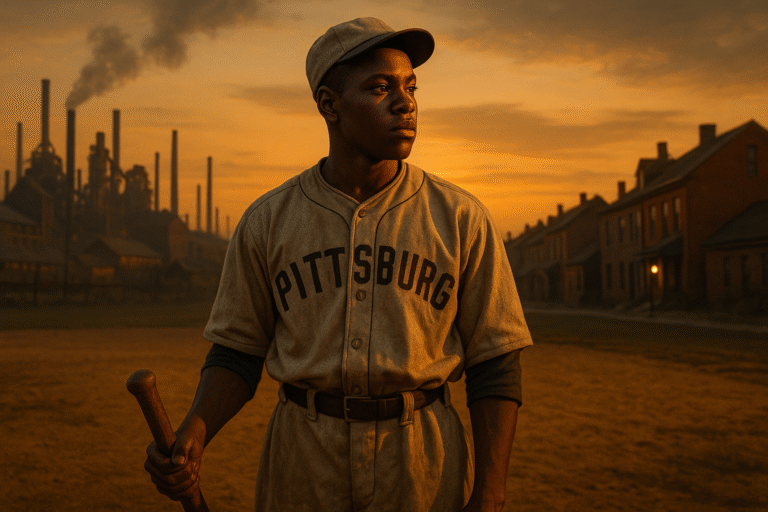From sandlots to legend, Josh Gibson changed the game.
His bat drew crowds. His leadership lifted teams. His resilience challenged segregation and pushed baseball forward.
The records are debated. The impact is not.
Josh Gibson’s Journey To Baseball Legend
The road to baseball greatness is not always lined with bright lights or the roar of packed stadiums. For Josh Gibson, one of the top baseball legends of the 20th century, the path was winding and filled with challenges from the very beginning. His ride through the Negro Leagues remains one of the most remarkable stories in all of sports history.
I have always been fascinated by how Gibson’s raw talent, determination, and resilience completely changed the game and inspired generations, even though he never played in Major League Baseball during his lifetime.

Josh Gibson’s Early Life and Introduction to Baseball
Josh Gibson’s story starts in Buena Vista, Georgia, in 1911. Not long after, his family made the move up to Pittsburgh, searching for better opportunities. The city itself played a big role in shaping his future, Pittsburgh would become a hub for Black baseball, and Gibson found himself in the middle of it all.
He started out playing sandlot ball, which, from what I have read and heard, was pretty common for kids in that era. Unlike today, there weren’t many organized leagues or high-end coaching. You learned a lot just by playing every chance you got in the neighborhood.
One thing that stands out about Gibson’s biography is how fast he developed into a powerful hitter. Local fans and scouts could not help but notice the way the game seemed to come so naturally to him. They say he had a knack for hitting towering home runs, sometimes ones that would clear the ballpark completely.
His name started getting mentioned more and more around local baseball circles, a big deal in Pittsburgh given the city’s rich history with both Negro League and Major League baseball. This early attention set the stage for what would become one of the most eye-catching rides in sports.
Gibson’s love for baseball grew each year. By his teens, he was spending nearly all his spare time on the diamond, catching for local teams while sharpening his bat skills. According to those who watched him play, Gibson exuded confidence and possessed a swing both smooth and powerful.
It’s easy to picture sandlot crowds gathering just to see if he would send another ball flying out of the park. With so much talent, it was only a matter of time before bigger teams started taking notice.
Breaking Through Barriers in the Negro Leagues
The Negro League history timeline is filled with stories of players who had to fight for every opportunity, and Gibson’s early years were no exception. He joined the Pittsburgh Crawfords in the late 1920s, at a time when racial segregation kept Black players out of the Major Leagues. It is heartbreaking that so much talent went unrecognized by most of the country, but that didn’t stop Gibson from finding new ways to pursue his passion.
During the 1930s, Gibson also played for the Homestead Grays, and this is where he stepped into the spotlight. Gibson’s name popped up everywhere in the sports pages, even in cities far from Pittsburgh. Reporters from both Black and mainstream newspapers made trips just to describe his home run power. There are countless stories—maybe exaggerated a bit, but who’s to say?—about him smashing balls out of Forbes Field and Yankee Stadium.
The statistics are tricky since official record-keeping in the Negro Leagues was not always reliable, but historians and researchers have pieced together a pretty impressive track record. He’s often credited with nearly 800 home runs in his career, though the exact number is debated. Even the most conservative estimates place him among the top sluggers in the history of baseball.
Gibson’s impact was not just about home runs, it was also about swinging open doors for future generations. As he moved between teams and cities, he drew huge crowds and inspired younger players watching from the stands.
Games involving Gibson often became major events, drawing fans from all backgrounds eager to see his bat in action. His presence gave the league a huge boost, showing everyone that Black players could be the main attraction and face of a franchise.
Facing Adversity On and Off the Field
It’s really important to remember the challenges faced by baseball players of color during Gibson’s playing days. Black players, no matter how talented, faced constant discrimination. They weren’t just fighting for wins; they were fighting for basic respect every time they walked onto the field.
Gibson dealt with long bus rides, poor accommodations, and paychecks that barely covered expenses. Sometimes, teams played three or four games in one day just to keep the league afloat.
There’s something almost unthinkable today about the level of pressure Gibson and his teammates dealt with. It wasn’t only about winning baseball games; it was about proving, over and over, that Black athletes deserved the right to compete at the highest level.
I think about the emotional toll that must have taken. Some nights, the only available lodging was a nearby train station bench or a kind neighbor’s living room. Even so, Gibson was known for staying upbeat and focused on the field, letting his play speak for itself.
Despite the hardships, Gibson found ways to lift team morale and show up as a leader. His positive attitude, according to former teammates, helped others through tough stretches. The Negro Leagues were infused with community pride, and Gibson became a symbol of hope and resilience in that tight-knit environment.
Josh Gibson’s Baseball Statistics and Playing Style
I’m always amazed at how Gibson’s numbers, even the ones that can be trusted as reasonably accurate, stack up against anyone in baseball history. His batting averages were consistently sky-high, even flirting with .400 in several seasons.
According to research by the Society for American Baseball Research (SABR), he once hit .441 in 1943. Those are video game numbers by today’s standards and show how dominating his bat was in real life.
Gibson was also surprisingly agile for a catcher and was known for his strong leadership behind the plate. He wasn’t just all offense; his defense mattered a lot. Pitchers leaned on him to manage games, call pitches, and handle critical defensive plays.
His arm was quick and accurate, making baserunners think twice about stealing. While tales of his mighty home runs fill the record books, Gibson’s defensive skills were a key reason he was so respected throughout the league.
Fans and opponents often said that Gibson brought an all-in-one blend of power, athleticism, and baseball IQ to every game. He set the bar high, not just for catchers, but for all players. This mix of offensive and defensive dominance is rare in any era and remains impressive today.
Josh Gibson’s Place in Baseball History
Looking at the top 10 moments in Negro League history, Gibson’s name surfaces often. From legendary home runs to epic showdowns against white Major Leaguers in barnstorming games, he made a massive impression.
There’s one story, though the details vary, about Gibson blasting a ball out of Yankee Stadium in an exhibition. Whether every single fact holds up or not, the way his legend grew shows how much people admired his game.
Gibson’s historical importance goes far beyond any single number or stat. He was part of a generation of players who paved the way for change with every game they played. His career, sadly, ended too soon, Gibson died young, at just 35, in 1947 (the same year Jackie Robinson debuted in MLB).
Still, his influence in sports remains huge. A lot of people call him the “Black Babe Ruth,” but that comparison doesn’t capture his full story. He had unique gifts and left a mark wholly his own. If you’re interested in learning more, the National Baseball Hall of Fame covers his induction and ongoing impact.
Gibson’s influence also stretches over to the modern era. Whenever discussions around Hall of Fame snubs or overlooked legends come up, his name is listed right at the top. He represents not just great baseball, but the fight for justice and equality, echoed in the stories of later trailblazers in all kinds of professions. His legacy continues to be celebrated with murals, books, documentaries, and ceremonies at ballparks across the nation.
Lessons from Josh Gibson’s Ride
I sometimes wonder what Gibson might have achieved if he’d had the same doors open to him as white players in the 1930s and ’40s. But his rise to baseball legend wasn’t only about slugging home runs—it was about perseverance, community, and pushing through barriers. For fans who got to watch Gibson swing a bat, there was more than entertainment on display; there was hope for a new, more equal future.
His story reminds me that overcoming adversity can feel impossible, and yet, the way Gibson kept working, always trying to improve, is something worth reflecting on. He wasn’t the only one battling those odds, many players in the Negro Leagues shared similar struggles, but few left a footprint as lasting as his. Whenever fans or historians talk about baseball’s greatest, Josh Gibson’s name rightly stands tall.
The inspiration he offers today stretches far outside baseball. Whether it’s young athletes dreaming big or anyone facing tough odds, Gibson’s life is a guide reminding us to keep going, bet on our talent, and never let others set limits for what we can accomplish.
Common Questions about Josh Gibson and the Negro Leagues
Answer: Even though the stats are incomplete, Gibson’s home run rates and batting averages regularly matched or topped the best MLB stars of the time. Some historians have argued he may have been the greatest power hitter of his generation.
Answer: Besides discrimination and segregation, Negro League schedules were incredibly tough. Players crisscrossed the country for little money, faced constant pressure to deliver excitement, and played at the highest level without the recognition they deserved.
Answer: Gibson’s impact goes beyond his era. Modern players, coaches, and fans often bring up Gibson when discussing breaking through barriers and showing perseverance. Honoring his life also means recognizing the contributions of every player who took the field in the Negro Leagues and made baseball better for everyone.
How Josh Gibson Inspires Modern Baseball
For anyone interested in baseball history, Gibson’s ride is more relevant than ever. His story urges us to look deeper than just stats or headlines; it asks us to pay attention to the people who set the groundwork for today’s popular game.
Watching old clips, reading about his life, or even visiting Negro League exhibits gives you a real sense of how the sport has grown to be more welcoming and more representative of all players.
If you are curious, digging into Gibson’s story opens up not just his legacy, but also the entire history of a sport that continues to grow and change. His rise from sandlots to legendary status offers big lessons about pushing through, refusing to be boxed in, and believing you can change the game.
There’s inspiration in Gibson’s journey for athletes, fans, and anyone working to move boundaries, whatever their field may be. Wrapping up, it’s clear that the game of baseball, and really all of sports, is richer for having had a talent and a spirit like Josh Gibson’s set it free on the field.



